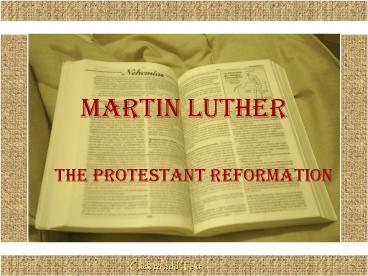Martin Luther - PowerPoint PPT Presentation
1 / 13
Title:
Martin Luther
Description:
Around 1517 Martin Luther, a German priest posted a list of grievances against ... The growth of Protestantism forced reform within the Catholic Church. ... – PowerPoint PPT presentation
Number of Views:113
Avg rating:3.0/5.0
Title: Martin Luther
1
Comunicación y Gerencia
- Martin Luther
The Protestant Reformation
- Click to add Text
2
Martin Luthers 95 Theses
- Around 1517 Martin Luther, a German priest posted
a list of grievances against the Roman Catholic
Church that included the sale of indulgences and
other church abuses
3
95 Theses - Grievances
- Indulgences
- Sacrament of Penance
- Existence of Purgatory
- Authority of the Pope
- Authority of the Priests
- Source of Salvation
- Seven Sacraments only 2 Biblical in nature
4
95 Theses
- 8. Wealth of the Catholic Church
- 9. Latin language used in service
- 10. Latin as language of the Bible
- 11. Abusive practices and torture to those
believed to be heretics - 12. Governing power of the Roman Catholic Church
- 13. Interpretation of Scripture
5
The Catholic Church Responds
- Church leaders saw Luthers views as an attack
against the fundamental beliefs of the church - 1521 Luther was excommunicated from the Church
- Luther was brought before the Diet of Worms
6
Diet of Worms
- Luther brought before an assembly of state
leaders in the city of Worms. - He refused to recant his teachings and postings
against the Catholic church. - Luther was declared a heretic and forbidden to
sell, print or write any further accusations
against the church. - Luther went into hiding.
7
The Reaction of the Catholic Church
- Luthers actions created a following and those
that spoke against the Roman Catholic Church were
excommunicated, accused of heresy and often
burned at the stake.
8
The Spread and Impact of the Reformation
- The growth of Protestantism forced reform within
the Catholic Church . - This movement was called the Counter-Reformation.
- Catholic leaders worked to strengthen the church
in response to the Reformation.
9
The Council of Trent
- A meeting, called by Pope Paul III, held by
church leaders that began in 1545 and worked for
18 years to combat the corruption within the
church. - The council gave a more precise statement of
Catholic teachings
10
Council of Trent
- The Catholic Churchs Reaction to the Protestant
Reformation through the Counter-Reformation - The Council of Trent hoped to appease those who
were the biggest supporters of the Protestant
Reform
11
Counter-Reformation Points
- Took steps to stop sale of religious offices.
- Prayers, not payments were the only acceptable
method of Penance. - Purgatory would still exist and be a way to
Salvation - There was no real change in the sole authority of
the Pope, however, laity and lower clergy had no
power
- The authority of the bishops and priests was
strengthened but they were expected to have more
authority within the community. - Good works as a way to salvation was reaffirmed.
- The seven sacraments were upheld.
- The wealth of the Catholic church was diminished,
could not acquire wealth through the selling of
church offices, only through charity.
12
Counter-Reformation Points
- Vernacular language was important for the people
to understand and be able to read Scripture and
to further their understanding of the Catholic
faith and Biblical teachings. - Logic and argument were to be used as defense of
beliefs put forth in the Catholic church, no
longer were the powers of the church allowed to
accuse people of heresy without just cause and
proof. - The pope would no longer be involved in the
politics of government and kings, his focus was
to be as a religious leader. - The interpretation of Scripture was to be in the
vernacular language and the focus of religion
should be the application of Scripture to life
13
(No Transcript)


























![Martin Luther Christian University - [MLCU], Shillong PowerPoint PPT Presentation](https://s3.amazonaws.com/images.powershow.com/9677188.th0.jpg?_=202110270610)




